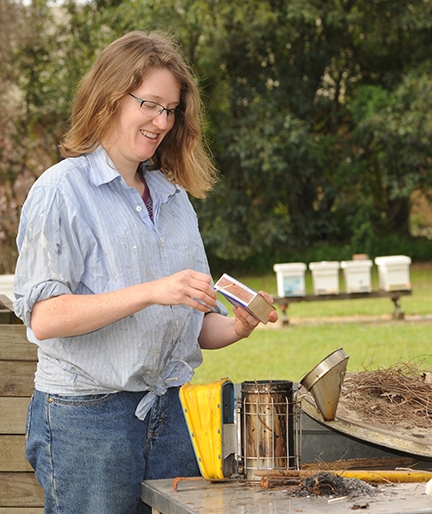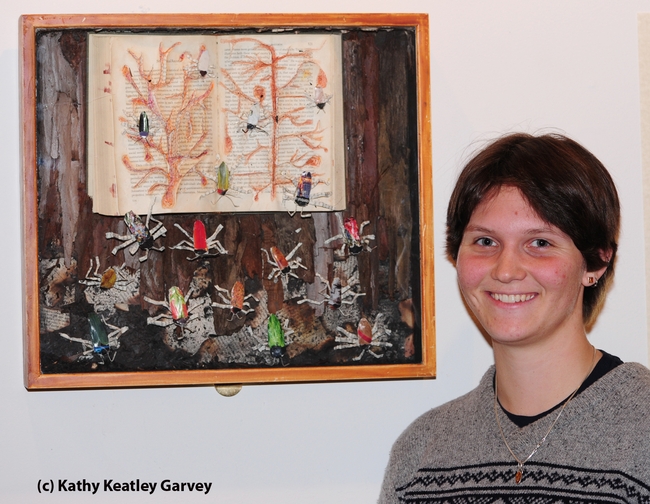- Author: Kathy Keatley Garvey

She's the newly hired honey bee development officer, an Extension-like position, in the state of New South Wales.
Frost left the States last Sunday, Jan. 10. The government position involves working with the commercial beekeeping industry in New South Wales in "course development and training, policy making, and other projects, including the importation of honey bee semen to Australia, and oxytetracycline prescriptions for European Foulbrood treatment, etc." she related.
We first met Liz in 2008 when she joined the Harry H. Laidlaw Jr. Honey Bee Facility as the staff research associate for bee breeder-geneticist Susan Cobey, then manager of the facility. Among her many duties, Frost maintained the apiaries and lab facilities, and aided in experiments and instruction in queen rearing and instrumental insemination.
We watched her lead tours with Cobey, now a geneticist-bee breeder at Washington State University; harvest honey; learn to drive the stick-shift bee truck; plant a pollinator garden in front of the Laidlaw facility; engage in a (private) bee bearding activity directed by Cobey; and even install pigeon-control devices on the eaves of the facility.
Frost also hosted the annual "Pi Day" every March 14 for faculty, staff and students at the Laidlaw facility. We all brought pies to celebrate the mathematical constant π (pi).
The Laidlaw facility buzzed with the enthusiasm, commitment and dedication of the Cobey/Frost team.
Frost, who holds a bachelor of arts degree in English and Italian from UC Davis with a minor in entomology, left the Laidlaw facility to join the Bee Informed Partnership, based in College Park, Md. (read her posts), and then headed off to Australia to become a honey bee development officer with the New South Wales government. From California to Australia...and now it's back to Australia...

As a honey bee development officer, she created educational tools for beekeepers in the form of an online Honey Bee Pest and Disease Course, a Queen Bee Breeding book in hard copy and online publication (iBook and EPUB), a bimonthly column (The Frost Report) in the New South Wales Apiarist Association magazine (Honey Bee News), face-to-face courses in queen breeding, and online fact sheets.
About the pest/disease course: "If a beekeeper with one or thousands of colonies wants to learn more about honey bee pests and diseases this course is a valuable, interactive tool with tutorials including videos to supplement the text, and short quizzes," she explained. "In Australia this is a nationally accredited course which awards participants units of competency upon successful completion of assessment tasks."
Her fact sheet on Hygienic Behavior Testing includes step- by-step instructions with illustrations. "Hygienic behavior is a honey bee trait which confers resistance to chalkbrood and American foulbrood (AFB), two serious brood diseases in Australia. AFB is especially serious in Australia considering it is illegal to treat AFB infected hives with oxytetracyline (OTC) as it only masks the symptoms and can contaminate honey. This fact sheet and others produced by New South Wales Dept. of Primary Industry Apiary Technical Officers are located on this site.
She also taught a course on queen bee breeding in Australia with co-worker Doug Somerville. The late Gretchen Wheen, a pioneer in instrumental insemination in Australia, played key roles in establishing two bee breeding programs in Western Australia and the Eastern States (Queensland, New South Wales, Victoria) and the Eastern Creek Quarantine Station which enabled safe, legal importation of new honey bee stock. (The course is listed on this site.)
"These products are educational tools for beekeepers worldwide, but are specifically geared toward the Australian beekeeping industry in regard to the subjects of relevant endemic and exotic pests and diseases and seasonal management and floral resources," Frost related. (She also appeared in this news media-produced video: "Frost Spreads the Beekeeping Gospel.")
When her VISA expired, Frost returned to the states and engaged in a number of projects, including a recent presentation to the California State Beekeepers' Association conference. She toyed with other apiculture opportunities in the States, but when the Australian opportunity surfaced, she made a beeline to return.
Liz Frost is excited to be back.
"Beekeeping in the Australian context is fascinating, not only because Varroa is absent in this country," she said. "The wealth of potential floral resources is astounding, giving beekeepers the opportunity to chase honey 12 months of the year. Around 70 to 80 percent of honey produced commercially is derived from eucalyptus and native forests. These stats shouldn't deceive the reader into thinking honey is easily had, however. The most successful honey producers in Australia know their country intimately. Part arborist, part meteorologist, and all beekeeper, they monitor buds on trees years in advance of a flowering event.
"Also to be considered is the fact that, while some native melliferous flora such as Yellow Box and Ironbark are profuse nectar producers in the right conditions, they can be seriously deficient as a pollen resource. This situation makes beekeeper management decisions before and after working such a honey crop vital to prevent colonies from working themselves to death in the absence of incoming and nutritious pollen."



- Author: Kathy Keatley Garvey

This beetle belongs to a large and varied order: their eltrya—the hardened outer wings that form the beetles’ iconic carapices—are jeweled purple and gold, colors that shift with motion. “A Study of Stillness in Motion,” the piece would be called. This particular beetle is green, so green your eyes slide off of it, like you’re looking at the greenest of greeniness, the very Form of green, and it is not for you to comprehend.--Whitney Krupp
So begins an insect tale, illustrated with her art, at the Organism show sponsored by the UC Davis Art/Science Fusion Program. It started out as a one-day show on Dec. 11, but by popular demand, evolved into a three-day show.
The last day to see it is Saturday, Dec. 15 from 6 to 9 p.m. The site: Old Nelson Art Gallery in the UC Davis Art Building (across from Shields Library).
Whitney Krupp, a second-year ecological management and restoration major from San Rafael, tells the story of a beetle, a fire, and a pictographs in her piece, "A Study of Stillness in Motion." You'll have to stop by to read what happens in this thought-provoking and creative piece.
Krupp is one of 15 entomology students showcasing insect tales and art. Another memorable one is by Nhu Mai who writes about "The Demise of the Hornet Who Thought He Could."
"New Japanese Giant hornet larvae have been born and the supply of food for the colony of hornets is now running extremely low on this cold autumn night in the mountains of Japan," Mai begins.
The hornet colony grows increasingly hungry and desperately needs food. So a hornet scout sets out to steal food from a honey bee hive. Spoiler alert: hornets kill honey bees and raid the colony of honey, immature brood, and adult bees.
This particular hornet, however, encounters a strategic maneuver. The bees swarm it, vibrate heat, and smother it.
Honey bees, Mai explains, can withstand 118-degree temperature, while a hornet "can only survive up to 115 degrees...Within seconds, the hornet is lifeless."
The 15 students wrote "curious tales about insects" and illustrated those stories "through their art pieces,” said show curator Anna Davidson, a Ph.D. student who's a teaching assistant with the UC Davis Art/Science Fusion Program. “The concept behind their art pieces is based on Cabinets of Curiosities, a pre-Linnaeus collection of curiosities made popular among the affluent in 14th and 15th century Europe.”
“During this show you will experience glow in-the-dark organisms, art made of fungus, large-scale installation, live performance, and sound art and tales about insects that are so curious they are almost unbelievable!” said Davidson, whose own work includes "art made of fungus."
The Organism show is not just about bees and beetles. You'll see assorted other insects, including monarch butterflies and praying mantids, brought to life through art and text.
While you're on the UC Davis campus (Saturday, Dec. 15), be sure to attend the Bohart Museum of Entomology's open house, themed "Insects in Art," from 1 to 4 p.m. in 1124 Academic Surge on Crocker Lane.
You'll get an opportunity to make a bug button--and maybe win a prize.





